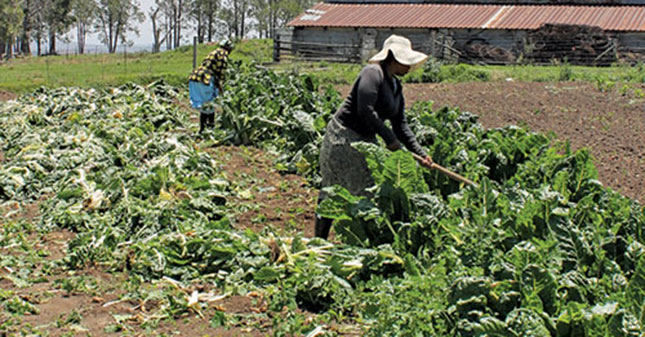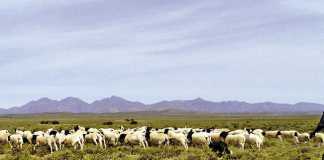
Photo: FW Archive
How has crop insurance in South Africa evolved during the past 50 years?
Crop insurance originated in the eastern Free State and was initially called farmers’ hail insurance. It started off very small, mainly focusing on grain crops, and now insures a variety of commodities including fruit and vegetables. It was initially offered by Sentra- oes Koöperatief, after which it was implemented by Agri Risk Specialists, which was then bought by Santam. Much research has been carried out on crop insurance and risk assessment procedures.
How can crop insurance contribute to long-term profitability and sustainability of a farming business?
One often hears of grain crops and other commodities that have been wiped out in a natural disaster such as hail. If farmers hadn’t taken out insurance on these crops, they would have had to cease farming. For this reason, insurance contributes significantly to the sustainability of farms and farmers alike. Multi-peril crop insurance is available on grain and fruit crops in certain areas and a wider variety of risks are covered, including frost damage.
And food security?
Food security is of major concern to insurers. According to a study released by the Human Sciences Research Council in June this year, more than half of all South Africans do not have regular access to enough food. For farmers, it depends on the time of the year the hail hits. They may have partial damage to crops but their yield may recover. If, however, there is a major crop loss through hail, not much can be done to recover it.
Insurance plays a role in keeping farmers in business for the following year, and maintaining skills levels in the industry by ensuring continuity. Crop failures can be as a direct result of natural disasters such as floods and droughts. This can lead to food insecurity, famine, loss of property and life, mass immigration and negative national economic growth. Agriculture is probably the most important sector in the economies of developing countries. In South Africa, it employs a large workforce that provides more than a million formal and informal job opportunities, in addition to feeding the nation.
Do you think South African farmers fully comprehend the benefits of insurance?
South Africa is one of the top seven agricultural exporting countries in the world. This is a major achievement considering the sector’s seasonality, generally dry production environment, and exposure to unfavourable climatic conditions. Most farmers are fully aware of the benefits that crop insurance or transfer of risk can offer, but if more farmers take out crop insurance, this will lead to lower premiums, since a wider base of people taking out insurance will then be carrying the financial load. Crop insurance provides peace of mind for the possibility that your whole crop may be demolished in a severe hailstorm.
What is the most important misconceptions about crop insurance?
As is the case with all insurance products, there is a level of risk that the farmer has to carry, called ‘risk for own account’. Misconceptions often arise when more is expected from the compensation without fully appreciating simple facts, such as the fact that lower premiums equals higher risk. Misconceptions surrounding policy conditions is another issue which sometimes crop up. This is often the case when farmers are covered for the direct damage caused by hail, but not for the potential secondary consequences such as disease or rust damage to crops. These are not insurable risks.
Farmers have to maintain normal farming practices after an incident such as hail damage, just as when a crop is not insured. What is the single most important mistake farmers make in terms of crop insurance?
With changes in climatic conditions, farmers are challenged by a higher frequency of natural weather phenomena such as a higher intensity of hailstorms, floods and drought. Variability in weather conditions is responsible for 80% of the fluctuations in agricultural production. A better understanding of medium- to long-term adverse weather conditions is needed.
Risks must be clearly identified based on the historical impact of disasters, trends of change, assessment of vulnerability and risk quantification. This information must be communicated to specialists such as crop insurers. Farmers must also keep in mind that it is beneficial to insure their crops as soon as possible to assure cover even before damage can result. Crop insurance premiums are paid for the entire season of a specific crop irrespective of the date that cover is taken out.
Are SA crop insurance products affordable for all farmers?
Crop insurance is influenced by a number of different variables, including the kind of crop grown and the weather conditions of a particular geographical area. For example, in northern KwaZulu-Natal and areas close to the Drakensberg where farmers produce soya beans, premiums are higher because of the location. It also depends on the type of crop, a tomato crop, for example, will be more expensive to insure than a maize crop. While the whole country is prone to extreme weather conditions, areas such the Northern Cape and KwaZulu-Natal are particularly prone to hail.
Crop insurance can serve as security for financial providers. Farmers have extremely high input costs to produce high value crops. Premiums for crop insurance should be considered a standard item on the input cost budget. Farmers do, however, have to offer security or some form of collateral. In the case of emerging farmers, this can become a challenge, where credit providers and applicants have to comply with the statutory requirements of the credit act.
What are the most popular crop insurance products?
These are the products that cover hail, wind and other perils, of which the favourite is hail cover. Disease is not covered by crop insurance because it’s something that farmers are expected to manage and prevent. Nonetheless, multi-peril insurance does cover farmers for uncontrollable diseases, or insect infestations for which there are no insecticides registered in South Africa to deal with the problem effectively.
Do you make provision for emerging and small farmers as a separate group?
Often small and emerging farmers require more support, and crop insurers often offer technical advice on site, ranging from calculating expected crop yields, to explaining the risks involved if a crop is destroyed. Government schemes assist small farmers with extension services and also work closely with crop insurers.
Do you know of any uniquely South African crop insurance products?
Our product is specific to the South African landscape, but each country has its own specific requirements. Common products such as hail insurance include cover for fire, transit risks and frost, which are available for certain crops at an additional premium. In South Africa, multi-peril crop insurance provides cover for most adverse climatic conditions. Cover is, however, based on individual producers’ long-term yield history, which will also determine the percentage cover allowed by insurers.
Are veld fires covered?
Separate veld fire cover has not been available in South Africa for some time due to excessive claims in the past. Risk of fire is dependent on the weather and thousands of hectares can be demolished if farmers face a particularly dry year. Provision for fire cover is made in the standard hail policy for grains, and fire cover is also available for fruit production. However, bodies such as the Fire Protection Agencies established by local farmers’ associations to reduce fire risks are excellent examples of farmers acting together to reduce their collective risk profiles.
With last year’s labour unrest in the Western Cape in mind, are there products against rioting, etc?
Sasria, a Section 21 company, was established to deal with riot and civil commotion risks in South Africa. With most crop insurance, farmers have the option of taking out Sasria cover if not already included in the premium. This cover will provide compensation for incidents of damage to property in the event of unrest, where damage to crops is caused by fire.
What does multi-crop insurance entail?
Multi-peril crop insurance (MPCI) covers uncontrollable loss of mass and grade (only for wheat and maize crops) of the insured crop caused by drought (crops being irrigated are excluded), excessive rain, water erosion, floods, snow, frost, hail, wind and cyclones. MPCI also provides for losses due to uncontrollable plant diseases, insect infestation and wild animals. Multi-peril crop insurance has become popular in recent years to secure funding of production costs for both grain and fruit crops. Cover is, however, subject to certain prerequisites such as long-term yield history, GPS farm maps, and copies of soil analysis.
What is the future of crop insurance?
Because farmers are particularly vulnerable to drought and hail, these will always be part of the risk associated with the industry. For this reason, crop insurance will remain a firm fixture on the agricultural landscape.
Phone Thomas Mills, communications consultant to Enrico Malan, on 011 775 5711.
This article was originally published in the 1 November 2013 issue of Farmer’s Weekly.













